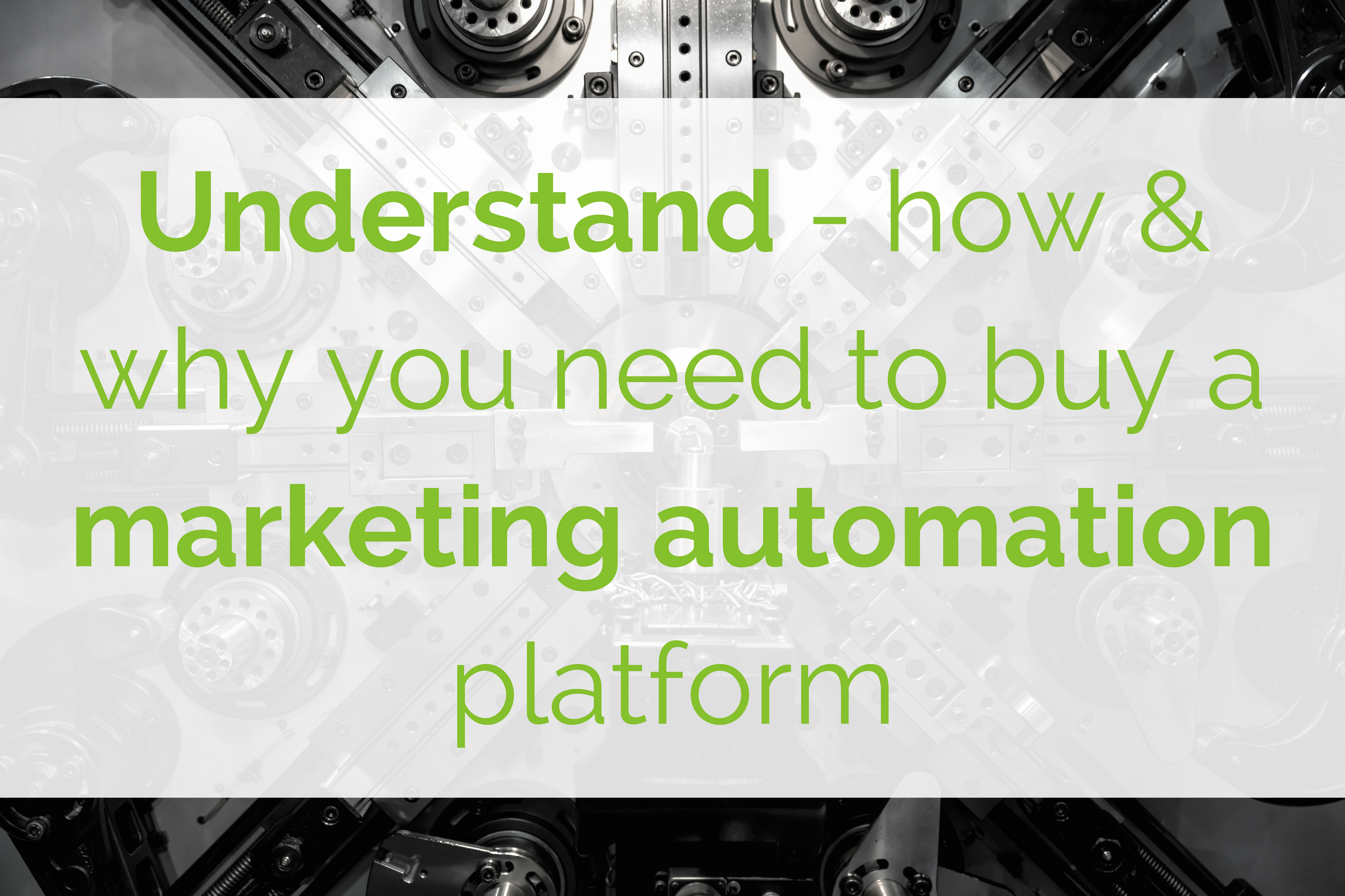BECOME W.I.S.E.R. with Your AI Prompts - A guide for sales managers
Everyone’s wittering on about AI like it’s the second coming. But here’s the rub: if you give it half-baked prompts, you’ll get half-baked answers....
5 min read
 Chris Fell
07/09/2017 11:56:37 AM
Chris Fell
07/09/2017 11:56:37 AM

Marketing automation tools are the not-so-secret weapon for B2B marketers. It allows you to focus on thinking... designing and creating compelling lead generation campaigns, rather than the doing...as the automation software should do the grunt work for you.
Sounds great right? Well yes, but making a decision on which automation platform suits your needs best, requires some thinking and some research. Here is a list of topics to consider:
A marketing automation tool doesn’t help you with your strategy. Marketing automation tools help automate a strategy. So, the first step when selecting a tool is to document your strategy. You need to think about:
How fast do I need to run my lead generation engine?
Its crticial to understand how much lead generation activity marketing you must do to support your firms growth goals. Understand how many visitors, contacts, qualified leads and customers you need to hit your growth goals. Use the reporting capabilities of your Market Automation Software (MAS) to compare your actual results to your strategy. If it's too low - you know you need to increase activity or improve lead conversion.
The secret to effective digital marketing is focusing clearly on your different target customers and their respective needs. Then different content streams should be targeted at those different personas. Ensure your MAS is able to allocate your marketing assets and tactcis to different persona campaigns so you can track effectiveness.
Outbound marketing strategies tend to focus on sending content or messages to prospects through telemarketing, direct mail, email, or other advertising campaigns. Inbound techniques are focused on getting customers to find you via search, referrals, social media, etc.
The results are quite clear, outbound techniques are rapidly decaying in their effectiveness. Inbound techniques work much better by attracting buyers to you, like a magnet. By "getting found" by buyers at a time and a channel of their choosing, conversion rates are up to 60% higher than outbound techniques meaning your cost per lead is optimised.
That said if you have a list of validated existing leads, outbound emails with a valid business reason, aligned around the customer's key pain points can be an effective outbound technique.
Evaluate your MAS' features against these requirements
Typically, mid sized and smaller companies look for a tool that integrates multiple functions in the one tool that is easy to learn and handles a wide variety of features. Large companies might seek out a tool that handles more complex use cases, but must be wary of the longer implementation times and particularly the specific skill sets required to operate the software. These resources are hard to find and usually very expensive and dwarf the costs of the software itself. In addition, larger companies tend to have staff segmented by task/skill and therefore might choose to use several marketing tools that are designed to go deep in certain areas.
One of the major advances in marketing software has been the widespread use of open APIs. This has big benefits for marketing departments as it allows you to plug in specialised software to the core marketing automation software. This is especially valuable for CRM software but also other tools such as event registration software like Eventbrite or proposal writing software such as proposify or webiste management tools such as Hotjar or Google analytics. Rather than look for a full technology stack that tries to do everything you can pick a core marketing automation product and then simply and easily plug in specialist tools to complete your stack.
Make sure your choice of marketing automation software has:
1) A genuinely open API
2) A robust ecosystem of partners, a marketplace if you like, whose software easily integrates with your core MAS platform without extensive (and expensive) custom coding.
Although most would agree that modern marketing is not a simple funnel, the best way to understand your automation requirements is considering these 3 stages.
A good first step in the marketing funnel is to make sure you can be found if someone is looking. This includes establishing a website optimised for search engines, making content available, and establishing and maintaining a social presence. Look for marketing automation tools that handle this part of the funnel as well as search marketing, content management, social media management and robust analytics.
After you’ve established a presence, you need to capture leads when they view your content or contact you. Make sure your marketing automation systems provides effective landing page and form creation as well as analytics to help you optimise your lead capture process. You should also look to score your leads based on the prospects’ behavior across all your touch points. There are four common places leads are captured:
Web - web forms and landing pages in front of your content that users access via your website, paid advertising or other domains. This is increasingly popular and effective so shoud be a core focus of your MAS capability.
Trade shows and events - Uploading captured leads via event management function. Look to integrate with a popular event management software, they do it best.
Emails - “cold emailing” to lists. Cold emailing is rapidly declining in effectiveness. If you must email ensure you are sharing content that is genuinely valuable to the target customer. Open rates are regularly low single digits, sometimes even less than 1%.
Call campaigns - “cold calling” to lists. Good luck, you're going to need it.

After establishing a presence and capturing leads, the leads need to be nurtured and ultimately converted to a sale. With marketing automation tools, you can nurture with custom content and messaging to individual leads to increase conversion.
Measure campaigns to optimise, justify and prioritise initiatives. Your boss will love you (or love you more!) if you can show them the return on investment - the real revenue that your campaigns have driven for the business vs the cost of generating that revenue.
Reduce time spent administering marketing programs and completing tasks - instead spend time on strategy and ideas; on how to really help your target buyers in cool and interesting ways.
Improve close rates with timely and relevant engagement. This is a big one, the data is clear, if you engage with leads quickly and with relevant information your conversion and close rates improve dramatically, reducing your cost of customer acquisition.
Consistent messaging across campaigns, channels and between marketing and sales by using templates and standard processes.
Shorter sales cycles.
Customised responses and content to each customer's pain points or needs.
Scheduled and automated activities for around-the-clock engagement without manual effort, that is best suited to when your buyers like to engage with your content.
Marketing automation is simple enough when you break it down. It helps companies market more effectively, and it does this by automating marketing actions (most of them tedious and time consuming).
While this seems elementary on the surface, marketing automation software can be quite complex. It certainly helps automate repetitive tasks such as email, social media, or digital advertising, but it can also give a business insight into who its customers are and what they like.
Using data stored within a CRM or similar system - marketing automation software can help identify ideal customers. This allows marketing teams to create hyper-personalised content to infuse in campaigns, reaching the right people with the right message at the right time.
Through this type of targeting, marketers are able to nurture prospects more effectively and hopefully, gain more satisfied, loyal customers. These personal relationships can often lead to a significant amount of new revenue and a full pipeline, which should make all businesses searching for the elusive ROI happy.
Marketing automation software can often be thought of as a fix-it-all solution that you can literally “set and forget.” This is a common misconception––marketing automation, like many other innovative technologies, works better with human expertise and management. It is not necessarily a way to reduce staffing costs, though it can in some cases, but is a way to better determine, target, and nurture customers.
For a full independent evaluation of the different MAS platforms head over to G2 Crowd's MAS grid.
If you want to find out how to implement or upgrade your current tools and would like to talk to a MAS consultant we'd be happy to help.
Subscribe to our latest news and updates on HubSpot.

Everyone’s wittering on about AI like it’s the second coming. But here’s the rub: if you give it half-baked prompts, you’ll get half-baked answers....

The business world is falling head over heels for AI—and who can blame it? With promises to reduce grunt work, uncover insights, and turbocharge...

Search is evolving - fast. For two decades, SEO has revolved around Google’s algorithm: keywords, backlinks, metadata, and page speed. But with the...